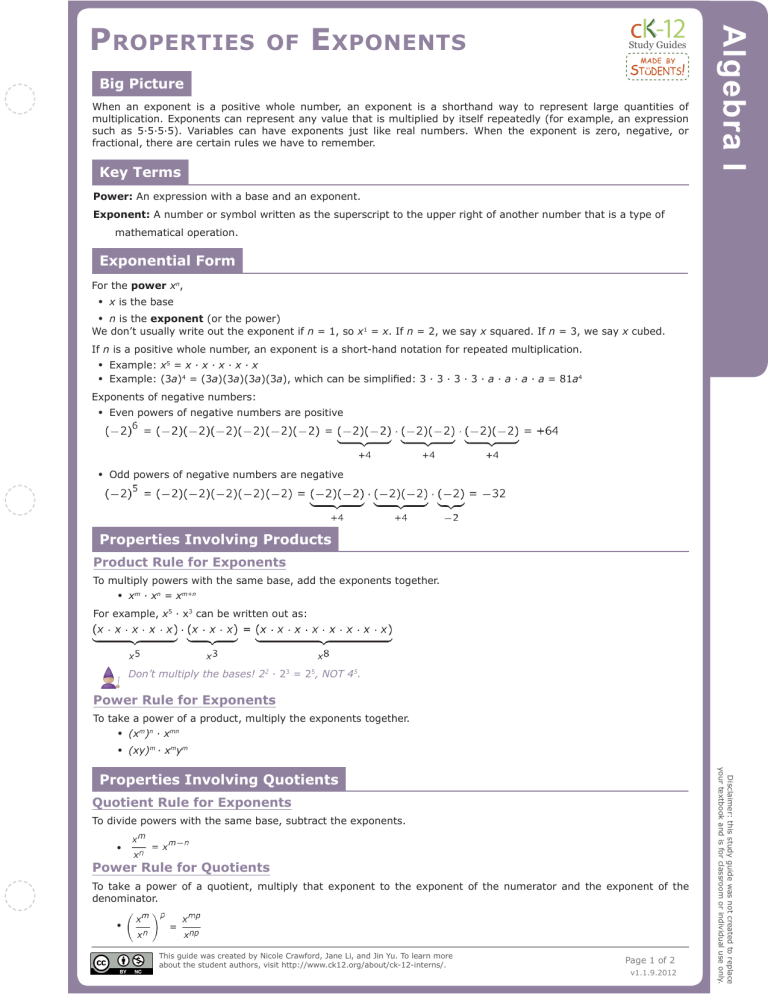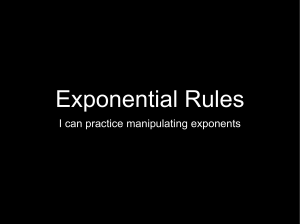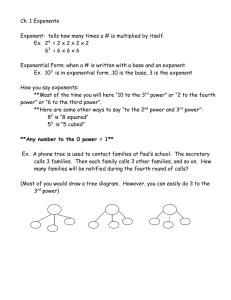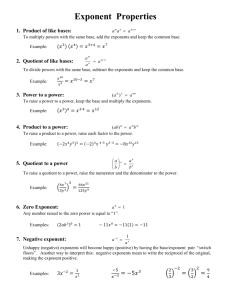
of Exponents Study Guides Big Picture When an exponent is a positive whole number, an exponent is a shorthand way to represent large quantities of multiplication. Exponents can represent any value that is multiplied by itself repeatedly (for example, an expression such as 5·5·5·5). Variables can have exponents just like real numbers. When the exponent is zero, negative, or fractional, there are certain rules we have to remember. Key Terms Algebra I Properties Power: An expression with a base and an exponent. Exponent: A number or symbol written as the superscript to the upper right of another number that is a type of mathematical operation. Exponential Form For the power xn, • • x is the base n is the exponent (or the power) We don’t usually write out the exponent if n = 1, so x1 = x. If n = 2, we say x squared. If n = 3, we say x cubed. If n is a positive whole number, an exponent is a short-hand notation for repeated multiplication. • • Example: x5 = x ∙ x ∙ x ∙ x ∙ x Example: (3a)4 = (3a)(3a)(3a)(3a), which can be simplified: 3 · 3 · 3 · 3 · a · a · a · a = 81a4 Exponents of negative numbers: • Even powers of negative numbers are positive • Odd powers of negative numbers are negative Properties Involving Products Product Rule for Exponents To multiply powers with the same base, add the exponents together. • xm · xn = xm+n For example, x5 · x3 can be written out as: Don’t multiply the bases! 22 ∙ 23 = 25, NOT 45. Power Rule for Exponents To take a power of a product, multiply the exponents together. • (xm)n · xmn • (xy)m · xmym Quotient Rule for Exponents To divide powers with the same base, subtract the exponents. • Power Rule for Quotients To take a power of a quotient, multiply that exponent to the exponent of the numerator and the exponent of the denominator. • This guide was created by Nicole Crawford, Jane Li, and Jin Yu. To learn more about the student authors, visit http://www.ck12.org/about/ck-12-interns/. Page 1 of 2 v1.1.9.2012 Disclaimer: this study guide was not created to replace your textbook and is for classroom or individual use only. Properties Involving Quotients Algebra I Properties of Exponents Zero, Negative, Fractional Exponents Zero Rule for Exponents Any number raised to the zero power is equal to 1. • x0 = 1 If you can’t remember this, use the quotient rule where the exponents of the numerator and the denominator are equal. Negative Power Rule for Exponents A number raised to a negative number is the same as a fraction with the exponent in the denominator. • and x ≠ 0 Example: Negative Power Rule for Fractions A fraction raised to a negative number is the same as taking the reciprocal of the fraction, then raising the numerator and denominator to the same exponent. • , where x ≠ 0 and y ≠ 0 Rule for Fractional Exponents A number raised to a fractional number is the same as taking the root of it. • Notes Page 2 of 2



